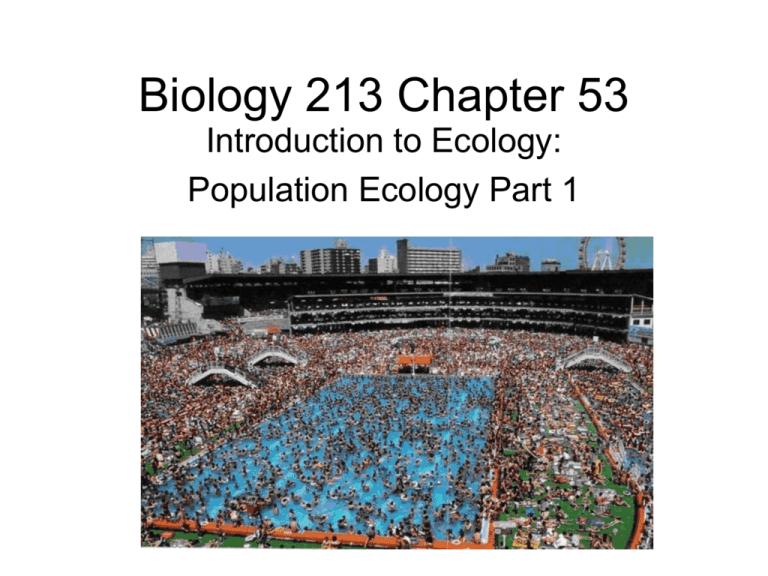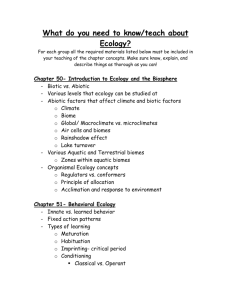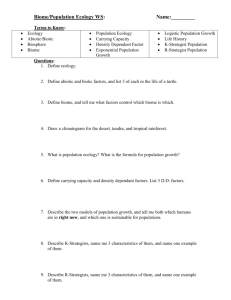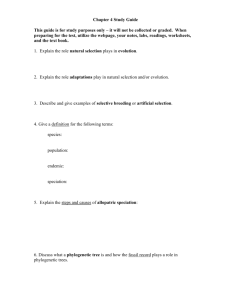Population - Rogue Community College
advertisement

Biology 213 Chapter 53 Introduction to Ecology: Population Ecology Part 1 You will be able to… • List various fields of study in Ecology • Explain what factors change populations • Calculate population rate changes • Compare and contrast densitydependent to density-independent factors Ecology: Oikos = home Ology = study of Integrates all biological fields 1. Organismal ecology: physiology, behavior, interactions with environment 2. Population ecology: factors affecting groups of individuals in an area. 3. Community ecology: interactions between species in an area 4. Ecosystem ecology: biotic and abiotic interactions; E flow & chem. Cycles 5. Landscape ecology: exchange of E & materials across multiple ecosystems 6. Global ecology: biosphere: regional exchange of E & materials affecting entire functioning & distribution of organisms wotldwide. Ecology & evolution: changes in environment impacting populations’ alleles over time. Ecology & environmental issues Complexity of Nature: Why are some species present in an area? Dispersal difficulties (accessibility?) Behaviour limits distribution (habitat preference)? Biotic factors: competition/parasitism/predation/etc Abiotic factors: Chem: H2O, O2, pH, salinity, nutrients Phys: Macro & micro climate: Temp, light, fire, soil composition, moisture • Estimate: one million years to get from 2.5 million to human population of ~ 5 million people in 6000 B.C. (2x) • population did not reach 500 million until almost 8,000 years later -about 1650 A.D (100x) • doubled roughly once every thousand years or so • reached a billion ~ 1850, doubling in 200 years • reached two billion around 1930 – doubling in 80 years • 1970’s it reached 4 billion ~ 40 year doubling time • Today’s population ~ 7 billion What factors have allowed human population to increase so rapidly? Ecologists study population trends rather than individual organisms. Properties of populations include • • • • • • Population size Population density Patterns of dispersion Demographics Population growth Limits on population growth • Population density – # individuals of a species per unit at a given time • Population dispersion (spacing) – How are individuals distributed in a habitat? – Why would this be important to know if you were studying a population? – What does a dispersion pattern tell you? Individual members distributed in a # of different ways: • Clumped - • Uniform • Random - Why would a clumped population pattern form? individuals _____________ to each other, or __________________________________. What factors encourage a uniform population pattern? individual organisms actively _____ each other or all _________________________________ What abiotic or biotic features would encourage a random population pattern? Rare in nature - occurs in absence of strong attractions or repulsions among individuals. Dispersion patterns and density may change over time Habitat changes: food, nutrients, water, sunlight (plants) Age / size / developmental stages change: • Four factors that produce changes in population size Natality: birth rate Mortality rates Mortality rate of cheetahs Increased Infant Mortality • Is the cheetah dangerously inbred? • Majority of deaths in wild due to predation. • Future for cheetah population? How a population changes: D in # of individuals in a certain period of time N= r= How a population changes: D in # individuals / time N = # individuals r= * Per 1,000 individuals Growth rate = Example: N = 300,000 humans: 3,000 births + 1,500 deaths in one year r = (birth rate) – (death rate) Example: N = 300,000 humans: r = (birth rate) – (death rate) r = r = Example: N = 300,000 humans: r = 0.005 x 100 = 0.5% increase rN = 0.5 x 300,000 rN = If r is positive, increase in pop. If r is negative, pop. is decreasing If r = 0, population is stable Are there other factors besides birth and death and size of a population that can change a population? Immigration • What causes immigration biologically? – Favorable factors Factors encouraging immigration: New environment made available –Natural disasters large and small –Competitive or predatory species goes extinct / moves away –Climate change or new resources –Hitch-hiking (“alien” species) Less competition in new area Succession after a disaster Immigrants have an opportunity to invade: Reduced competition Factors that encourage successful immigration: Distribution methods: • dispersal is at or near ground level vs. aerial dispersal • dispersers actively engage in searching, or not • dispersers able to orient toward preferred habitat from some distance, or not Wind dispersing Golden Orb spiders Emigration Unfavorable Factors: *Excessive competition: mates or food *Lack of resources *Disease *Avoidance of in-breeding Population change includes immigration and emigration: r = (birth rate) – (death rate) plus (immigration – emigration) e.g. Example: N = 300,000 humans: 3000 births + 1500 deaths in one year 3,000 immigrated into the area 9,000 emigrated out of the area r = (b – d) + (i – e) b – d = (10/1000) – (5/1000) = 0.005 i – e = 1/1000 – 3/1000 = 0.001 – 0.003 = -0.002 r = (b – d) + (i – e) = (0.005) + (-0.002) = 0.003 x 100 = 0.3% Growth rate: rN = (0.3%)(300,000) = 900 more people in the population Intrinsic rate of increase (rmax) Maximum rate at which species or population can increase under ideal conditions • Exponential population growth Exponential population growth According to Malthus: • Population, when unchecked, increases in a geometrical ratio. • Subsistence increases arithmetically. Carrying capacity –Carrying capacity (K) = largest population maintained without degrading environment they live in –Changes as environment changes • Logistic population curve (S-shaped curve) Carrying capacity and logistic population growth Limiting Factors Density-dependent factors –Regulate population growth by affecting large proportion of population as population rises: Density-dependent factors –What do you think would impact a population as it got bigger? • Predation • Disease • Competition • Toxic wastes Density-dependent factors and negative feedback • Density-independent factors – Limit population growth but are not influenced by changes in population density: usually ABIOTIC – Examples include natural disasters: • Hurricanes • Blizzards • Forest fires • Mudslides • Volcanoes, tsunamis, and earthquakes Limiting Factors Biotic and abiotic, Density dependent or independent factors that limit a population’s growth: What would be a limiting factor? What can you think of that would be a limiting factor? Which are biotic and which are abiotic? • increase death rate • decrease birth rate • limits immigration • encourages emigration • Any factors that slows population growth. How are up & down cycles explained? Can be very complex relationships and factors. Biology 213 Chapter 53 Introduction to Ecology: Population Ecology Part 2 You will be able to… • Explain what factors change populations • Calculate population rate changes • Compare and contrast density-dependent to density-independent factors • Analyze human population patterns and make predictions about future trends • Semelparous reproduction –Expend their energy in a • Iteroparous reproduction –Exhibit ________________________ throughout their lifetimes Semelparity: Expend energy to reproduce in one big effort Most insects, invertebrates, many annual plants, and some fish What’s the advantage? Iteroparous reproduction • Expend energy to reproduce in cycles • Most vertebrates, perennial plants. • What’s the advantage? Species exhibiting an r strategy –Emphasizes a high growth rate –Organisms typically have • small body size • high reproductive rates • short life spans • inhabit variable environments • Often Species exhibiting a K strategy –Maintains a population near carrying capacity (K) of environment –Species often have • large body size • low reproductive rates • long life spans • inhabit stable environments • Often • Survivorship curves –Type I • Mortality is greatest in old age –Type II • Mortality is spread evenly across all ages –Type III • Mortality is greatest among the young Survivorship curves Survivorship curve for a herring gull population Source habitats: –Preferred habitats –Local reproductive success is > local mortality –Local individuals disperse from source habitats to other regions • Sink habitats –Lower-quality habitats –Individuals may suffer death or poor reproductive success –What would make an organism move then? Source & sink populations in a hypothetical metapopulation Human population growth – World population reaches 7,000,000,000 6,668,926,425 by Mayyear 20, 2008 The 2011 – Per capita growth rate declined from peak in 1965 of about 2% per year (doubling time 35 years) – to 1.3% per year (doubling time of 54 years) – birthrate necessary for zero population growth is 2.1 births per woman Human population growth: exponential J-shaped curve so far logistic population growth Chapter 53 Clicker Question #4: Often growth cycles of one population affects the cycle of another. As moose populations increase, wolf populations also increase. If we consider the logistic equation for the wolf population: dN = rN (K-N) dt K which of the above factors accounts for the strongest impact on the moose population? A. K B. dN C. rN D. dt Population characteristics –Highly developed countries • low birth rate • low infant mortality • low fertility rate • long life expectancies • high GNI PPP: –GNI PPP per capita is the gross national income in purchasing power parity divided by mid-year population. Population characteristics –Developing countries • high birth rate • high infant mortality • high fertility rate • short life expectancies • low GNI PPP What trends do we see world-wide? China and India’s populations increasing Birth rate decline lags behind as death rate decreases: e.g. in Mexico, 1900–2000 • Age structure influences population dynamics –Possible for country to have replacement-level fertility and still experience population growth –Young age structure causes a positive population growth momentum as large pre-reproductive age group matures Age structure diagrams comparing Kenya to USA to Germany 15-to-40 range: reproductive rates are high “Carrying-capacity" definition of overpopulation: • not population density, but #’s of people in an area relative to resources capacity to sustain human activities • a condition of overpopulation might be corrected with no change in the number of people! Ecological Footprint • Developing countries tend to have people overpopulation that degrades the environment • Developed countries have consumption overpopulation that degrades the environment USA & Mexico One week’s food supply. One week’s food costs the American family $341.98 One week’s food Egypt Ecuador Above: Bhutan Below: Chad One week’s food costs the Chad family $1.23 • • • • China has 22 % of world’s population India has 17 % of world’s population Both nations are modernizing rapidly USA uses has 4.4% of the world population and uses 25% of world’s energy resources • What happens to global resources when developing countries want to enjoy a developed nation lifestyle like ours?






